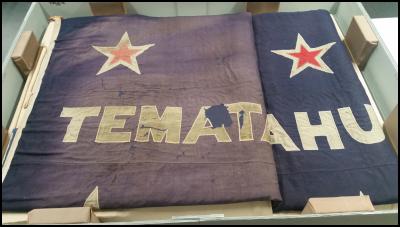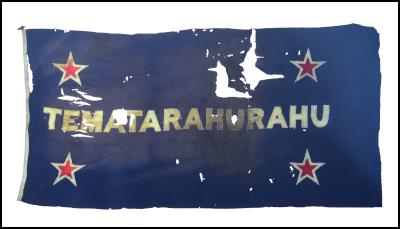Hōne Heke’s tribal flag comes to Auckland

Hōne Heke’s tribal flag comes to Auckland in time for the referendum
As the New Zealand flag debate rages on,
the Museum of Transport and Technology (MOTAT) is preparing
to welcome legendary Hōne Heke’s original tribal flag to
Auckland.
This powerful taonga from the Te Matarahurahu hapū, the first Māori clan to sign the Treaty of Waitangi, will travel from Waitangi to be unveiled during a dawn pōwhiri at MOTAT on Thursday 3 March 2016.
The loan was arranged by Ngāpuhi leader David Rankin to emphasise the important role Māori have played in the historical flag debate; from Hōne Heke’s rebellion through to the service of the Māori battalion.
“We want to give people greater access to this taonga and encourage them get involved with the New Zealand flag selection process. It’s a pan-cultural debate and everyone should have their say. Heke’s flag is a symbol of the controversy which has surrounded flags in New Zealand over the years and this latest debate is another crucial chapter in that history,” says Mr Rankin.
The flag will be displayed at MOTAT alongside other significant flags such as the Māori flag, the current New Zealand flag and the proposed new design as the country goes to vote in the final flag referendum from 3 to 24 March. The installation will emphasise the national significance of flags as well as the process, innovation and technology involved with their design.

“The Matarahurahu flag was designed by the nineteenth century warrior, Hōne Heke to supplant the United Tribes flag and the Union Jack hoisted by the British. This was an issue he felt so passionately about that he famously felled the flagstaff in Russell (formerly known as Kororāreka) on several occasions,” says Mr Rankin. Heke’s vivid rejection of the symbol of British power over Māori sparked the bloody ‘Flagstaff Wars’ and the fundamental New Zealand flag debate.
The exact age of Heke’s flag is unknown but it was flown from his pā sites throughout Northland and on his own family marae until the 1950’s. It has previously been on display at The Museum of New Zealand Te Papa Tongarewa, the National Museum of Australia and the Melbourne Museum.
ENDS


 Gordon Campbell: On Peter Dutton’s Fading Election Prospects.
Gordon Campbell: On Peter Dutton’s Fading Election Prospects. Te Uru Kahika: Environment Report Demonstrates Critical Role Of Regional Science In New Zealand’s Future
Te Uru Kahika: Environment Report Demonstrates Critical Role Of Regional Science In New Zealand’s Future NZCTU: Transformative Policy Vision For Aotearoa
NZCTU: Transformative Policy Vision For Aotearoa Sensible Sentencing Trust: Greens Claim Intellectual Property Rights And Demand Changes To “Defund The Police” Billboards
Sensible Sentencing Trust: Greens Claim Intellectual Property Rights And Demand Changes To “Defund The Police” Billboards Te Pūtahitanga o Te Waipounamu: New Research Finds Dumped South Island Whānau Ora Agency An Exemplar Of Effective, Community-Led Public Service Delivery
Te Pūtahitanga o Te Waipounamu: New Research Finds Dumped South Island Whānau Ora Agency An Exemplar Of Effective, Community-Led Public Service Delivery NZ Nurses Organisation: Nurses’ Union Backs Call To Scrap Anti-Treaty Bill
NZ Nurses Organisation: Nurses’ Union Backs Call To Scrap Anti-Treaty Bill New Zealand Defence Force: Final Court Of Inquiry Into HMNZS Manawanui Grounding And Sinking In Samoa Released
New Zealand Defence Force: Final Court Of Inquiry Into HMNZS Manawanui Grounding And Sinking In Samoa Released


